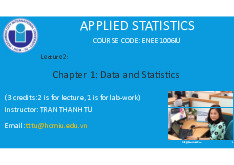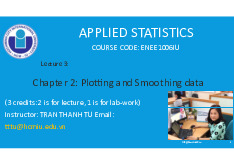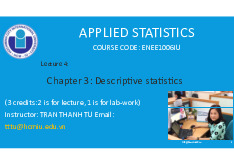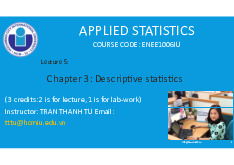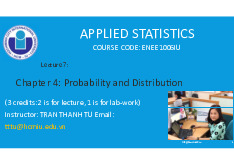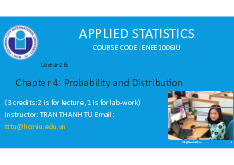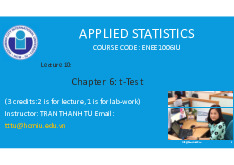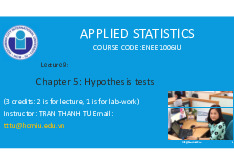Applied statistics (ENEE1006IU)
Danh sách Tài liệu
-
Data and Statistics | Bài giảng số 1 chương 1 học phần Applied statistics | Trường Đại học Quốc tế, Đại học Quốc gia Thành phố Hồ Chí Minh
228 114 lượt tải 28 trangAn error in data acquisition occurs whenever the data value obtained is not equal to the true or actual value that would be obtained with a correct procedure. Experienced data analysts take great care in collecting and recording data to ensure that errors are not made. Special procedures can be used to check for internal consistency of the data. -> Taking steps to acquire accurate data can help ensure reliable and valuable decision-making information. Tài liệu giúp bạn tham khảo, ôn tập và đạt kết quả cao. Mời bạn đón xem.
Danh mục: Trường Đại học Quốc tế, Đại học Quốc gia Thành phố Hồ Chí MinhMôn: Applied statistics (ENEE1006IU)Dạng: Bài giảngTác giả: VietJack1 năm trước -
Data and Statistics | Bài giảng số 2 chương 1 học phần Applied statistics | Trường Đại học Quốc tế, Đại học Quốc gia Thành phố Hồ Chí Minh
304 152 lượt tải 23 trangIdentifies and mitigates any preferences on the part of the investigators or data providers that might predetermine or influence the analyses / results. Employs selection or sampling methods and analytic approaches appropriate and valid for the specific question to be addressed, so that results extend beyond the sample to a population relevant to the objectives with minimal error under reasonable assumptions. Tài liệu giúp bạn tham khảo, ôn tập và đạt kết quả cao. Mời bạn đón xem.
Danh mục: Trường Đại học Quốc tế, Đại học Quốc gia Thành phố Hồ Chí MinhMôn: Applied statistics (ENEE1006IU)Dạng: Bài giảngTác giả: VietJack1 năm trước -
Plotting and Smoothing data | Bài giảng số 3 chương 2 học phần Applied statistics | Trường Đại học Quốc tế, Đại học Quốc gia Thành phố Hồ Chí Minh
182 91 lượt tải 27 trangHistogram: show the frequency distribution for quantitative data over a set of class intervals. Place the variable of interest on the horizontal axis and the frequency, relative frequency, or percent frequency on the vertical axis. Draw a rectangle whose base is determined by the class limits on the horizontal axis and whose height is the corresponding frequency, relative frequency, or percent frequency. Tài liệu giúp bạn tham khảo, ôn tập và đạt kết quả cao. Mời bạn đón xem.
Danh mục: Trường Đại học Quốc tế, Đại học Quốc gia Thành phố Hồ Chí MinhMôn: Applied statistics (ENEE1006IU)Dạng: Bài giảngTác giả: VietJack1 năm trước -
Descriptive statistics | Bài giảng số 4 chương 3 học phần Applied statistics | Trường Đại học Quốc tế, Đại học Quốc gia Thành phố Hồ Chí Minh
173 87 lượt tải 24 trangRatio scale: a weight of 4 grams is twice as heavy as a weight of 2 grams Interval scale: a temperature of 10 degrees C should not be considered twice as hot as 5 degrees C. If it were, a conflict would be created because 10 degrees C is 50 degrees F and 5 degrees C is 41 degrees F. Clearly, 50 degrees is not twice 41 degrees. a pH of 3 is not twice as acidic as a pH of 6, because pH is not a ratio variable. Tài liệu giúp bạn tham khảo, ôn tập và đạt kết quả cao. Mời bạn đón xem.
Danh mục: Trường Đại học Quốc tế, Đại học Quốc gia Thành phố Hồ Chí MinhMôn: Applied statistics (ENEE1006IU)Dạng: Bài giảngTác giả: VietJack1 năm trước -
Descriptive statistics | Bài giảng số 5 chương 3 học phần Applied statistics | Trường Đại học Quốc tế, Đại học Quốc gia Thành phố Hồ Chí Minh
207 104 lượt tải 22 trangSometimes a data set will have one or more observations with unusually large or unusually small values. These extreme values are called outliers. An outlier may be a data value that has been incorrectly recorded that needed to be corrected or removed before further analysis. Standardized values (z-scores) can be used to identify outliers. Treat any data value with a z-score less than −3 or greater than +3 as an outlier. Tài liệu giúp bạn tham khảo, ôn tập và đạt kết quả cao. Mời bạn đón xem.
Danh mục: Trường Đại học Quốc tế, Đại học Quốc gia Thành phố Hồ Chí MinhMôn: Applied statistics (ENEE1006IU)Dạng: Bài giảngTác giả: VietJack1 năm trước -
Probability and Distribution | Bài giảng số 7 chương 4 học phần Applied statistics | Trường Đại học Quốc tế, Đại học Quốc gia Thành phố Hồ Chí Minh
185 93 lượt tải 30 trangNormal approximation of binomial probabilities: The binomial random variable is the number of successes in the n trials, and probability questions pertain to the probability of x successes in the n trials. Binomial probability refers to the probability of exactly x successes on n repeated trials in an experiment which has two possible outcomes (commonly called a binomial experiment). Tài liệu giúp bạn tham khảo, ôn tập và đạt kết quả cao. Mời bạn đón xem.
Danh mục: Trường Đại học Quốc tế, Đại học Quốc gia Thành phố Hồ Chí MinhMôn: Applied statistics (ENEE1006IU)Dạng: Bài giảngTác giả: VietJack1 năm trước -
Probability and Distribution | Bài giảng số 8 chương 4 học phần Applied statistics | Trường Đại học Quốc tế, Đại học Quốc gia Thành phố Hồ Chí Minh
197 99 lượt tải 31 trangWhenever a simple random sample is selected and the value of the sample mean is used to estimate the value of the population mean µ, we cannot expect the sample mean to exactly equal the population mean. The practical reason we are interested in the sampling distribution of x is that it can be used to provide probability information about the difference between the sample mean and the population mean. Tài liệu giúp bạn tham khảo, ôn tập và đạt kết quả cao. Mời bạn đón xem.
Danh mục: Trường Đại học Quốc tế, Đại học Quốc gia Thành phố Hồ Chí MinhMôn: Applied statistics (ENEE1006IU)Dạng: Bài giảngTác giả: VietJack1 năm trước -
Probability and Distribution | Bài giảng số 6 chương 4 học phần Applied statistics | Trường Đại học Quốc tế, Đại học Quốc gia Thành phố Hồ Chí Minh
215 108 lượt tải 46 trangAddition Law: is helpful when we are interested in knowing the probability that at least one of two events occurs. That is, with events A and B we are interested in knowing the probability that event A or event B or both occur. Addition Law: two concepts related to the combination of events: the union of events and the intersection of events. The union of A and B is the event containing all sample points belonging to A or B or both. The union is denoted by A U B. Tài liệu giúp bạn tham khảo, ôn tập và đạt kết quả cao. Mời bạn đón xem.
Danh mục: Trường Đại học Quốc tế, Đại học Quốc gia Thành phố Hồ Chí MinhMôn: Applied statistics (ENEE1006IU)Dạng: Bài giảngTác giả: VietJack1 năm trước -
t-Test | Bài giảng số 10 chương 6 học phần Applied statistics | Trường Đại học Quốc tế, Đại học Quốc gia Thành phố Hồ Chí Minh
161 81 lượt tải 19 trangA t-test on the difference of the averages would conclude that A and B are not different. Sometimes it is not possible to pair the tests, and then the averages of the two treatments must be compared using the independent t-test. Example: Even if water specimens were collected on the same day, there will be differences in storage time, distribution time, water use patterns, and other factors. Tài liệu giúp bạn tham khảo, ôn tập và đạt kết quả cao. Mời bạn đón xem.
Danh mục: Trường Đại học Quốc tế, Đại học Quốc gia Thành phố Hồ Chí MinhMôn: Applied statistics (ENEE1006IU)Dạng: Bài giảngTác giả: VietJack1 năm trước -
Hypothesis tests | Bài giảng số 9 chương 5 học phần Applied statistics | Trường Đại học Quốc tế, Đại học Quốc gia Thành phố Hồ Chí Minh
177 89 lượt tải 38 trangOf course, not all hypothesis tests involve research hypotheses. First, we consider applications of hypothesis testing where we begin with a belief or an assumption that a statement about the value of a population parameter is true. We will then use a hypothesis test to challenge the assumption and determine if there is statistical evidence to conclude that the assumption is incorrect. In these situations, it is helpful to develop the null hypothesis first. The null hypothesis H0 expresses the belief or assumption about the value of the population parameter. Tài liệu giúp bạn tham khảo, ôn tập và đạt kết quả cao. Mời bạn đón xem.
Danh mục: Trường Đại học Quốc tế, Đại học Quốc gia Thành phố Hồ Chí MinhMôn: Applied statistics (ENEE1006IU)Dạng: Bài giảngTác giả: VietJack1 năm trước

